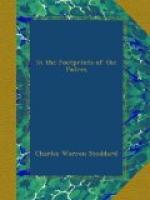Happy Valley! I remember one cool twilight when a “prairie schooner,” that was time-worn and weather-beaten, drifted down Montgomery Street from Market Street, and rounded the corner of Sutter Street, where it hove to. You know the “prairie schooner” was the old-time emigrant wagon that was forever crossing the plains in Forty-nine and the early Fifties. It was scow-built, hooded from end to end, freighted with goods and chattels; and therein the whole family lived and moved and had its being during the long voyage to the Pacific Coast.
On this twilight evening the captain of the schooner, assisted by a portion of his crew, deliberately took down part of the fence which enclosed a sand-lot bounded by Montgomery, Sutter and Post Streets; driving into the centre of the lot; the horses—four jaded beasts—were turned loose, and soon a camp-fire was lighted and the entire emigrant family gathered about it to partake of the evening meal. On this lot now stands the Lick House and the Masonic Hall—undreamed of in those days. No one seemed in the least surprised to find in the very heart of the city a scene such as one might naturally look for in the heart of the Rocky Mountains and the wilds of the great desert, or the heights of the Humboldt. No doubt they thought it a Happy Valley; and well they might, for they had reached their journey’s end.
A stone’s throw from that twilight camp, on the south side of Market Street, stood old St. Patrick’s Church. It was a most unpretending structure, and was quite overshadowed by the R.C. Orphan Asylum close at hand. Both were backed by sandhills; and both, together with the sand, have been spirited away. The Palace and Grand Hotels now stand on the spot. The original St. Patrick’s still exists; and, after one or two transportations, has come to a final halt near the Catholic cemetery under the shadow of Lone Mountain. It must be ever dear to me, for within its modest rectory I met the first Catholic clergyman I ever became acquainted with; and within it I grew familiar with the offices of the Church; though I was instructed by the Rev. Father Accolti, S.J., at old St. Ignatius’, on Market Street; and by him baptized at the St. Mary’s Cathedral, on the corner of California and Dupont Streets, now the church of the Paulist Fathers. I have referred to dear old St. Patrick’s—which was dedicated on the first Sunday in September, 1851—in the story of my conversion, a little bit of autobiography entitled “A Troubled Heart, and How It was Comforted at Last.” The late Peter H. Burnett, first Governor of California, was my godfather.
In 1855 St. Mary’s Cathedral was the handsomest house of worship in the city. For the most part, the churches of all denominations were of the plainest, not to say cheapest, order of architecture. As a youth, I sat in the family pew in the First Presbyterian Church, situated on Stockton Street, near Broadway. Well I remember my father, with others of the congregation—all members of the Vigilance Committee,—at the sound of the alarm-bell, rising in the midst of the sermon and striding out of the house to take arms in defence of law and order.




